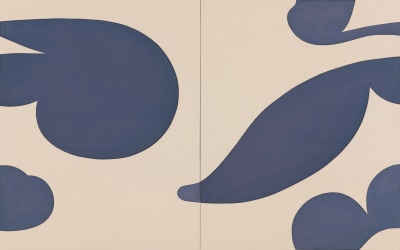Biography
"The Arizona-born, New York-based artist creates graceful biomorphic compositions by pooling paint on raw canvas: a process that is both meditative and meticulous; the results sparse and minimalist." – Financial Times
"Landon Metz proposes a visual aesthetic for an alternative mode of being to the fast-paced hullabaloo of modern urban life" – ArtReview
"Metz's latest show presents some of his largest works to date: massive wall-to-wall paneled works that, while static, appear to hover across the expanse of the gallery." – Hypebeast
Waddington Custot is pleased to announce our second show of Brooklyn-based artist Landon Metz (b.1985, Arizona, USA), in which he presents a striking new series of paintings in his trademark style. In Metz's conceptual practice, painting is used as a tool to draw attention to the phenomenon of sensory experience. His pared-back works on raw canvas, characterised by a single, biomorphic motif in acrylic wash, have a stark simplicity.
As modern society becomes increasingly fast-paced, stress and time paucity are celebrated as signs of diligence and ambition. Relentless streams of images and opinions reach us every day, via multiple channels. Metz's paintings, without being didactic in any specific sense, propose an alternative mode of being; his open, abstract paintings provide a moment of stillness. Viewers are invited to pause, and to take a moment to reflect on their present surroundings: noting the temperature of the room, of any slight breeze, of their physical and emotional state in that moment. Here Metz interprets the idea of American avant-garde composer John Cage, that in being prompted to listen to ostensible silence, we are able to consciously perceive the ambient noises which are around us at any given moment.
For his new exhibition, Metz expands Cage's idea and applies it spatially. The artist has thoughtfully choreographed the gestures of the paintings around the gallery, leaving empty the spaces traditionally reserved for paintings. Series of works are hung floor-to-ceiling above one another, or abut one another down the length of the gallery; others appear to fold around corners of the room. Behaving unusually in this way, the paintings command attention as human-made interventions, drawing attention to the negative spaces within the gallery which are usually ignored.
With artistic influences ranging from Morris Louis and Ellsworth Kelly to Helen Frankenthaler, Metz sits squarely in the grand tradition of painters working out of New York City; his approach can be understood as a reinterpretation of the radical practices emerging out of the mid-twentieth century. Like Frankenthaler, Metz adopts the soak-stain method, applied to the horizontal canvas; with Kelly he shares a drive toward evocative and joyful painting, using unadorned shapes derived from architecture and nature. The resultant visual language is unmistakably Metz's own.
Read more-
 Landon Metz, MMXXIV XXXI, 2024
acrylic wash on canvas
37 x 139 1/2 in
94 x 354.3 cm
%3Cdiv%20class%3D%22artist%22%3E%3Cspan%20class%3D%22artist%22%3E%3Cstrong%3ELandon%20Metz%3C/strong%3E%3C/span%3E%3C/div%3E%0D%3Cdiv%20class%3D%22title%22%3E%3Cem%3EMMXXIV%20XXXI%3C/em%3E%2C%202024%3C/div%3E%0D%3Cdiv%20class%3D%22medium%22%3Eacrylic%20wash%20on%20canvas%3C/div%3E%0D%3Cdiv%20class%3D%22dimensions%22%3E37%20x%20139%201/2%20in%3Cbr%20/%3E%0A94%20x%20354.3%20cm%3C/div%3E
Landon Metz, MMXXIV XXXI, 2024
acrylic wash on canvas
37 x 139 1/2 in
94 x 354.3 cm
%3Cdiv%20class%3D%22artist%22%3E%3Cspan%20class%3D%22artist%22%3E%3Cstrong%3ELandon%20Metz%3C/strong%3E%3C/span%3E%3C/div%3E%0D%3Cdiv%20class%3D%22title%22%3E%3Cem%3EMMXXIV%20XXXI%3C/em%3E%2C%202024%3C/div%3E%0D%3Cdiv%20class%3D%22medium%22%3Eacrylic%20wash%20on%20canvas%3C/div%3E%0D%3Cdiv%20class%3D%22dimensions%22%3E37%20x%20139%201/2%20in%3Cbr%20/%3E%0A94%20x%20354.3%20cm%3C/div%3E -
 Landon Metz, MMXXIV XXX, 2024
acrylic wash on canvas
10 1/4 x 16 1/2 in
26 x 41.9 cm
Landon Metz, MMXXIV XXX, 2024
acrylic wash on canvas
10 1/4 x 16 1/2 in
26 x 41.9 cm
-
 Landon Metz, MMXXIV XXXV, 2024
acrylic wash on canvas
62 1/2 x 150 3/4 in
158.8 x 382.8 cm
%3Cdiv%20class%3D%22artist%22%3E%3Cspan%20class%3D%22artist%22%3E%3Cstrong%3ELandon%20Metz%3C/strong%3E%3C/span%3E%3C/div%3E%0D%3Cdiv%20class%3D%22title%22%3E%3Cem%3EMMXXIV%20XXXV%3C/em%3E%2C%202024%3C/div%3E%0D%3Cdiv%20class%3D%22medium%22%3Eacrylic%20wash%20on%20canvas%3C/div%3E%0D%3Cdiv%20class%3D%22dimensions%22%3E62%201/2%20x%20150%203/4%20in%3Cbr%20/%3E%0A158.8%20x%20382.8%20cm%3C/div%3E
Landon Metz, MMXXIV XXXV, 2024
acrylic wash on canvas
62 1/2 x 150 3/4 in
158.8 x 382.8 cm
%3Cdiv%20class%3D%22artist%22%3E%3Cspan%20class%3D%22artist%22%3E%3Cstrong%3ELandon%20Metz%3C/strong%3E%3C/span%3E%3C/div%3E%0D%3Cdiv%20class%3D%22title%22%3E%3Cem%3EMMXXIV%20XXXV%3C/em%3E%2C%202024%3C/div%3E%0D%3Cdiv%20class%3D%22medium%22%3Eacrylic%20wash%20on%20canvas%3C/div%3E%0D%3Cdiv%20class%3D%22dimensions%22%3E62%201/2%20x%20150%203/4%20in%3Cbr%20/%3E%0A158.8%20x%20382.8%20cm%3C/div%3E -
 Landon Metz, MMXXIV XXXIX, 2024
acrylic wash on canvas
63 1/4 x 39 5/8 in
160.6 x 100.6 cm
%3Cdiv%20class%3D%22artist%22%3E%3Cspan%20class%3D%22artist%22%3E%3Cstrong%3ELandon%20Metz%3C/strong%3E%3C/span%3E%3C/div%3E%0D%3Cdiv%20class%3D%22title%22%3E%3Cem%3EMMXXIV%20XXXIX%3C/em%3E%2C%202024%3C/div%3E%0D%3Cdiv%20class%3D%22medium%22%3Eacrylic%20wash%20on%20canvas%3C/div%3E%0D%3Cdiv%20class%3D%22dimensions%22%3E63%201/4%20x%2039%205/8%20in%3Cbr%20/%3E%0A160.6%20x%20100.6%20cm%3C/div%3E
Landon Metz, MMXXIV XXXIX, 2024
acrylic wash on canvas
63 1/4 x 39 5/8 in
160.6 x 100.6 cm
%3Cdiv%20class%3D%22artist%22%3E%3Cspan%20class%3D%22artist%22%3E%3Cstrong%3ELandon%20Metz%3C/strong%3E%3C/span%3E%3C/div%3E%0D%3Cdiv%20class%3D%22title%22%3E%3Cem%3EMMXXIV%20XXXIX%3C/em%3E%2C%202024%3C/div%3E%0D%3Cdiv%20class%3D%22medium%22%3Eacrylic%20wash%20on%20canvas%3C/div%3E%0D%3Cdiv%20class%3D%22dimensions%22%3E63%201/4%20x%2039%205/8%20in%3Cbr%20/%3E%0A160.6%20x%20100.6%20cm%3C/div%3E -
 Landon Metz, MMXXIV XXVI, 2024
acrylic wash on canvas
36 1/4 x 58 in
92.1 x 147.40 cm
%3Cdiv%20class%3D%22artist%22%3E%3Cspan%20class%3D%22artist%22%3E%3Cstrong%3ELandon%20Metz%3C/strong%3E%3C/span%3E%3C/div%3E%0D%3Cdiv%20class%3D%22title%22%3E%3Cem%3EMMXXIV%20XXVI%3C/em%3E%2C%202024%3C/div%3E%0D%3Cdiv%20class%3D%22medium%22%3Eacrylic%20wash%20on%20canvas%3C/div%3E%0D%3Cdiv%20class%3D%22dimensions%22%3E36%201/4%20x%2058%20in%3Cbr%20/%3E%0A92.1%20x%20147.40%20cm%3C/div%3E
Landon Metz, MMXXIV XXVI, 2024
acrylic wash on canvas
36 1/4 x 58 in
92.1 x 147.40 cm
%3Cdiv%20class%3D%22artist%22%3E%3Cspan%20class%3D%22artist%22%3E%3Cstrong%3ELandon%20Metz%3C/strong%3E%3C/span%3E%3C/div%3E%0D%3Cdiv%20class%3D%22title%22%3E%3Cem%3EMMXXIV%20XXVI%3C/em%3E%2C%202024%3C/div%3E%0D%3Cdiv%20class%3D%22medium%22%3Eacrylic%20wash%20on%20canvas%3C/div%3E%0D%3Cdiv%20class%3D%22dimensions%22%3E36%201/4%20x%2058%20in%3Cbr%20/%3E%0A92.1%20x%20147.40%20cm%3C/div%3E -
 Landon Metz, MMXXIV XXVIII, 2024
acrylic wash on canvas
36 1/4 x 58 in
92.1 x 147.40 cm
%3Cdiv%20class%3D%22artist%22%3E%3Cspan%20class%3D%22artist%22%3E%3Cstrong%3ELandon%20Metz%3C/strong%3E%3C/span%3E%3C/div%3E%0D%3Cdiv%20class%3D%22title%22%3E%3Cem%3EMMXXIV%20XXVIII%3C/em%3E%2C%202024%3C/div%3E%0D%3Cdiv%20class%3D%22medium%22%3Eacrylic%20wash%20on%20canvas%3Cbr%20/%3E%0A%3C/div%3E%0D%3Cdiv%20class%3D%22dimensions%22%3E36%201/4%20x%2058%20in%3Cbr%20/%3E%0A92.1%20x%20147.40%20cm%3C/div%3E
Landon Metz, MMXXIV XXVIII, 2024
acrylic wash on canvas
36 1/4 x 58 in
92.1 x 147.40 cm
%3Cdiv%20class%3D%22artist%22%3E%3Cspan%20class%3D%22artist%22%3E%3Cstrong%3ELandon%20Metz%3C/strong%3E%3C/span%3E%3C/div%3E%0D%3Cdiv%20class%3D%22title%22%3E%3Cem%3EMMXXIV%20XXVIII%3C/em%3E%2C%202024%3C/div%3E%0D%3Cdiv%20class%3D%22medium%22%3Eacrylic%20wash%20on%20canvas%3Cbr%20/%3E%0A%3C/div%3E%0D%3Cdiv%20class%3D%22dimensions%22%3E36%201/4%20x%2058%20in%3Cbr%20/%3E%0A92.1%20x%20147.40%20cm%3C/div%3E -
 Landon Metz, MMXXIV XXXIII (II), 2024
acrylic wash on canvas
46 1/2 x 37 in
118.1 x 94 cm
Landon Metz, MMXXIV XXXIII (II), 2024
acrylic wash on canvas
46 1/2 x 37 in
118.1 x 94 cm
-
 Landon Metz, MMXXIV XXXII (III), 2024
acrylic wash on canvas
46 1/2 x 37 in
118.1 x 94 cm
Landon Metz, MMXXIV XXXII (III), 2024
acrylic wash on canvas
46 1/2 x 37 in
118.1 x 94 cm















